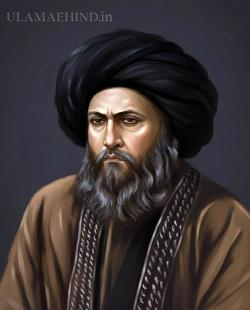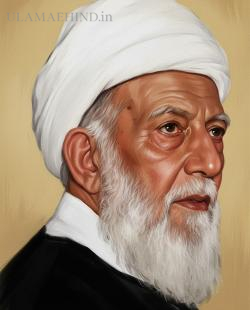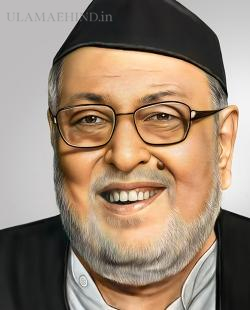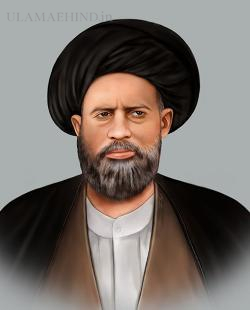Allamah Tafazzul Husain Khan Kashmiri (1727–1801) (Urdu: علامہ تفضل حسین کشمیری), also known as Khan-e-Allama, was a Twelver Shia scholar, physicist, and philosopher. He is famous for his arabic translation of Sir Isaac Newton's Principia.
Early life and education
Allama Tafazzul Husain Kashmiri was born to an influential Kashmiri family in Sialkot in 1727. His grandfather, Karamullah, was a great scholar of his time and served as a minister under Mir Mannu, governor of Lahore. At the age of 13, his father moved to Delhi, where he studied basic logic and philosophy under Mulla Wajih, a student of the eminent Sunni scholar Mulla Nizam-ud-Din. He learned Mathematics from Mirza Muhammad Ali. At the age of 18, his family moved to Lucknow where he joined the seminary of Firangi Mahal. Soon he developed doubts about the teachings of Sunni Islam and philosophy and moved out of the seminary, and started to research on his own. He then converted to Shia Islam and studied modern science and astronomy of his age.[1] He had learned pseudo-scientific philosophy of Mulla Sadra in Firangi Mahal,but moved on. Historian of science, Simon Schaffer, writes:
"Born in northern Sialkot in the year of Newton’s death, Tafazzul belonged to an eminent family who were converts to Shi’ism and close to the fading Mughal court. He studied logic, mathematics and natural philosophy in the imperial capital at Delhi, then moved to Awadh in 1745, where he rose rapidly in favour with the Nawāb Shujā’u‘d-Dawla. Tafazzul enrolled in Lucknow at the celebrated college at Firangī Maḥal, a former Dutch trader’s house taken over in the name of the emperor Aurangzeb in 1693 for the cultivation of a neoteric curriculum developed by the learned Nizām-ud dīn Sahalvī, where material from the rationalist tradition of Greco-Arabic texts was taught to candidates for courtly and administrative responsibilities. The college’s training was valued within both Mughal and British systems of erudition and government. Urban notables such as Tafazzul’s clan politically exploited the resources of Indo-Persian literary and natural philosophical culture and the rationalist sciences he studied in Delhi and Lucknow. Immersion in classical logic and mathematics, including Islamic commentaries on Euclid and Ptolemy, was combined with mastery of administrative and civil law.
Scholarly career
Nawab Shuja ud Daula appointed him tutor to his son Saadat Ali Khan in Allahabad. There the then young Syed Dildar Ali Naqvi, who later came to be known as Ghufran Maab, became his student. In the time of Nawab Asif ud Daula, Allama Kashmiri was appointed as an ambassador to the court of governor general of East India Company at Calcutta. There he learnt Greek, Latin and English and started to translate scientific works of European scientists into Arabic to bridge the gap between the scientific revolution and the Muslim and Indian educational institutions.[1] Science had flourished in the 18th century Europe due to public discussions in coffee houses, pubs, shops, fairs and other public places. By the end of eighteenth century CE, Calcutta had become a major center of cultural exchange where several scientific works, like James Ferguson's "Introduction to Electricity", Tiberius Cavallo's "A Complete Treatise on Electricity" and his "Essay on Theory and Practice of Medical Electricity", George Adams's "Essays on Electricity", Thomas Beddoes's "Factitious Airs", Jean-Antoine Chaptal's "Chemistry" and scholarly journals like the "Philosophical Magazine", were in circulation. The members of The Asiatic Society, founded by William Jones in 1784, held discussions on philosophy.
Simon Schaffer writes about Tafazzul's eagerness to translate state of the art knowledge:
"Tafazzul would reportedly spend his mornings on commentaries on Islamic tradition and philosophy and in teaching mathematics; dine with British colleagues; then in the afternoon and evening expound on his expertise in the contrasting schools of Islamic law. To improve his command of the Company’s language, he read a ‘history of England’ but ‘I have since given it up.’ His former colleague William Blane, now physician in Lucknow, acted as a go-between: Blane told Anderson that Tafazzul ‘generally spends an hour or two with me every other day in reading English books … those on Astronomy he is most fond of … you may send him a few books in that science or in the higher branches of Mathematics.’ The vakīl started work on more challenging and rewarding materials, mainly obtained via Burrow and his friends. These included canonical texts of eighteenth-century mathematics and rational mechanics, such as the 1769 Mechanics of the eccentric Wearside mathematician William Emerson, a work that offered its students a reliable version of Galilean kinematics and rational analysis. Tafazzul also studied the Treatise of algebra (1745) by Thomas Simpson, the mathematics professor at the Royal Military Academy at Woolwich, and a 1707 treatise on conic sections by the French mathematical analyst Guillaume de l’Hôpital."[5]
Works
He authored the following:
Commentary on Conica of Appollonus.
Two treatise on Algebra.
Commentary on Conica of Diophantus.
Translation of Sir Isaac Newton's Principia.
A book on Physics.
A book on Western Astronomy.
Simon Schaffer writes:
"The ambition to translate Newton was certainly remarkable. By the time of Tafazzul's arrival in Calcutta there had been but one English (Andrew Motte, 1729) and one French (Marquise de Châtelet, 1759) translation of Newton's Latin treatise. The project seems to have begun in mid-1789 and continued for some time with Reuben Burrow's encouragement. In September 1789 William Jones told William Palmer, by then British representative at Sindhia's camp, that ‘his friend’ Tafazzul was planning an Arabic version of Newton. Reports of progress with the work were sent by Tafazzul to Anderson and by Burrow to Shore. Burrow proposed accompanying the translation with his own notes. He reported to the Asiatic Society in November 1790 that ‘the small time I had to spare … has been employed in writing a comment on the works of Newton, and explaining them to a very ingenious native [i.e. Tafazzul], who is translating them into Arabic.’ For Tafazzul this was a development of his program to master and incorporate the resources of British rational astronomy. His Shi’ite colleagues explained the intimate relationship between the development of this astronomy and the importance of public and courtly patronage of learning: they saw an important link between the pursuit of such sciences and the status of learned elites within administration and government."[6]
Some of these books were taught in Shia seminaries in the nineteenth century Lucknow.[1] His successor, Saadat Ali Khan, founded an observatory in Lucknow. Nawab Ghaziuddin Haider and Nawab Nasiruddin Haider patronized modern scientific learning0
Collaboration with James Dinwiddie
In 1792, Scottish science communicator James Dinwiddie, tried his luck in China but failed to impress the Emperor. Faced with financial crisis, in 1794 he migrated to Calcutta in the hopes of better prospects, and started a series of lectures on natural science and staged demonstrations of scientific phenomena. He also offered private tuitions on mathematics, astronomy and geometry.[4] He believed that without mathematical reasoning one could not dig deeper in science. He said:
"Only in those parts of the science which have been mathematically considered, that natural philosophy can boast of having carried on her investigations with certainty, success and utility."
He believed that without mathematically described knowledge, one could not go beyond a schoolboy's understanding of science.[4] Allama Tafazzul Husain Kashmiri had already translated Newton's "Principia" into Arabic in 1789. After Dinwiddie started teaching in Calcutta, in October 24, 1794, the old Allama enrolled himself as a student. Dinwiddie first taught him Optics and then modern geometry. To his surprise, Tafazzul was struggling with mathematics. He rermarked:
"It is somewhat irregular that a man who reads so much theory should be so totally ignorant of practical mathematic.
James Dinwiddie notes in his diary: "Much jarring between the Nabob and Tafazzul Husain - the N told him he must not consider himself as his (the N's) servant but the servant of the English." Dinwiddie Journal B 39–13 May 1797.
Allama was also burdened with the job of ambassador of Awadh, and he had to discontinue the tuitions. Back in Lucknow, the nawab was unhappy and called him 'servant of the English', for becoming too occupied with learning and translation of modern scientific knowledge. In November 1795, he resumed and this time Dinwiddie taught him experimental astronomy. The exchange was mutual, as Tafazzul also informed Dinwiddie on Indian and Arabic astronomy.
Opposition from Sunni orthodoxy
Famous Sunni theologian of the time, Shah Abdul Aziz, son of Shah Waliullah Dehlawi, considered him an apostate because of some of his views.
Disciples
Nawab Saadat Ali Khan
Ayatollah Dildar Ali Naseerabadi
Death
In 1799, he suffered a brain hemorrhage which left his body in a state of paralysis. He died travelling from Banaras to Lucknow on 3 March 1801. Mirza Abu Talib Khan wrote the following elegy upon receiving the news of his death while in London:
"Alas! The zest of Learning's cup is gone;
Whose taste ne’er cloy’d, tho’ deep the draughts;
Whose flavor yet upon the palate hangs
Nectareous, nor Reason's thirst assuag’d
But yes; – rent is the garment of the morn;
And all dishevell’d floats the hair of night;
All bath’d in tears of dew the stars look down
With mournful eyes, in lamentation deep;
For he, their sage belov’d, is dead; who first
To Islam's followers explain’d their laws,
Their distances, their orbits, and their times,
As great Copernicus once half divin’d,
And greater Newton proved; but, useless now,
Their work we turn with idle hand, and scan
With vacant eye, our own first master gone."































